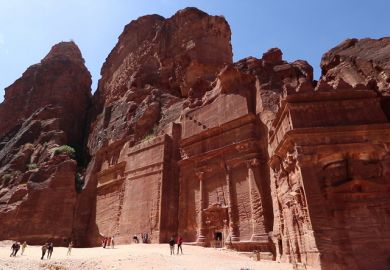The unwary purchaser of this book is likely to be misled: the title and the glossy dust-jacket photographs - of diggers at work, a lab technician and a museum display - suggest yet another of those portmanteau introductions for the archaeological tyro. Not a bit of it: this is hardcore, written by the great and good of the 50-ish generation of (mainly) British university prehistorians, and aimed at a market of graduate students and professionals on both sides of the Atlantic.
It is not a "companion" in the sense of those useful Oxford volumes on English, music, the theatre and so on with numerous short pieces (even "Shakespeare" in the theatre book has only nine pages), but a beefy set of essays.
While a number of these essays do what we might expect - notably, the exceptionally clear chapters by John Gowlett on chronology, Peter Rowley-Conwy on bioarchaeology, Ian Morris on classical archaeology, Matthew Johnson on social theory and Mark Pollard on archaeological science - some of the contributions are a bit rarefied even for the target market and written in dense social-science jargon that seems to aim for the initiated rather than the interested.
This is a pity since John Bintliff has pursued his contributors assiduously to deliver a wide-ranging (though somewhat oddly organised) volume, inspired by Ron Johnston's geographical polemics and Terry Eagleton's survey of literary theory - a field even more fissiparous than archaeology.
One pleasing emphasis, made by Stephen Shennan in "Analytical archaeology", Michael Shanks in "Archaeology and politics" and Bintliff in "Experiencing archaeological fieldwork", is the importance of the late David L. Clarke (1938-76), probably the most original and important thinker in British archaeology in the second half of the 20th century. His book Analytical Archaeology (1968) and a subsequent Antiquity article "Archaeology: the loss of innocence" (1973) set the agenda for an entire generation of scholars, quite a few of them contributors to this volume.
His tragic death left that generation leaderless, although a decade later his pupil Ian Hodder (oddly, not a contributor here) launched a "post-processual archaeology" with a free-ranging approach of which Clarke would have been proud.
Much of what we have here is similarly eclectic, although almost everybody acknowledges, implicitly or otherwise, that archaeology today is part of a broader social and political context - Clarke's "loss of innocence" - and that the ivory tower is untenantable.
In the opening section, "Thinking about archaeology", Shennan is joined by Julian Thomas, introducing German thinkers such as Heidegger and Hans-Georg Gadamer and their French counterparts such as Pierre Bourdieu, who have influenced so much recent archaeological theorising.
Later Shanks explains them rather better and also brings in the Frankfurt School and the French critical theorists (although it is surprising overall to find such paucity of reference to Foucault and Derrida).
A section on "Current themes and novel departures" includes essays on ancient DNA by Martin Jones, on archaeolinguistics by Roger Blench and on the archaeology of technology by Kevin Greene, all "state-of-play" assessments with intelligent discussion.
There are also Marie-Louise S?rensen's clear account of how an "archaeology of gender" emerged from the feminist movement and Johnson's assessment of both gender and other forms of social grammar that influence material culture.
Fokke Gerritsen, one of only two continental European contributors (apart from Bintliff, who, like them, teaches in the Netherlands) argues for a localised "archaeology of communities", while Bintliff goes to the opposite extreme with a grandiose attempt to bring the Annales approach, the punctuated equilibrium of Niles Eldredge and Stephen Jay Gould, and chaos theory into a single harness. It does not quite hang together, like Roland Fletcher's opaque discussion of human spatial organisation and behaviour.
"Material patterning of space is far too complex and multiscaled to be reduced to a verbal descriptor," Fletcher says, referring us instead to an unreadable and unexplained illustration.
Bintliff does much better in his chapter on fieldwork - where he is not only clear but provocative in arguing that "there are powerful but neglected reasons to elevate the importance of practical research in archaeology over thinking about the discipline... the excitement of fieldwork discovery which most grips the public is correctly focused on the cutting-edge of the discipline".
Those of us who have borne the neo-empiricist standard for years in the face of those who regard doing archaeology as the rather dirty last resort of the theoretically bankrupt are glad to welcome a convert.
Some of the contributors to the largest section of the book, "Major traditions in archaeology in contemporary perspective", seem to be of like mind. John Gowlett's two chapters on chronology make it clear that "when?"
is still a vital question across much of the world. Contributions from Tony Wilkinson on landscape archaeology, Fekri Hassan on the importance of ecology and Rowley-Conwy on reconstruction of environment and diet from bones, seeds and most recently ancient DNA show how we can build up a picture of "where", "what" and "how" en route to explaining "why".
Wilkinson makes a neat counterintuitive point: that the archaeological sites we find are not only differentially preserved in different ecozones, because of attrition in areas where ancient settlement was densest, deepest and often earliest, but that in more marginal zones the number of sites may be larger because of frequent shifting between scattered resources by smaller and less complex social groups.
His development of Christopher Taylor's underappreciated concept, a generation ago, of landscapes of survival versus landscapes of destruction now embraces also "landscapes of protection" such as the Ceide Fields in County Mayo, Ireland - a complete Neolithic settlement pattern buried under blanket bog since the Bronze Age - and the Maya cities of the Yucatan Peninsula,Mexico, engulfed by tropical forest 1,000 years ago.
One of the first areas in which systematic landscape surveys were done was Greece, where sparse vegetation and visible material culture made such work both obvious and feasible. From the pioneering Minnesota Messenia survey, through the Southern Argolid work of Tjeerd Van Andel and Curtis Runnels emphasising landscape evolution, the Boeotian surveys of Anthony Snodgrass and Bintliff, and Susan Alcock's analysis of Roman Greece, the combination of a rich historical record and a background of traditional studies of art and artefacts have made this one of the potentially most informative areas of the world for empirical discovery and the fine-tuning of method.
Ian Morris shows how this wealth of material kept classical archaeologists apart from many of the most stimulating, as well as obfuscatory, debates of the past few decades, but concludes that his discipline is rapidly integrating itself into the broader historical archaeology of complex societies.
The final section, "Archaeology and the public", includes Timothy Darvill and Joseph Tainter on the organisational, legal and financial problems in Europe and America respectively of what is now called "archaeological resource management", reconciling the need to protect the historic environment with the economic realities of modern development.
Martin Bell brings in a Green perspective, and shows how cooperation in conservation strategy can save both environmental and archaeological resources at the same time. From the profitless conflict at Twyford Down in the early 1990s to the careful investigations on the Newbury Bypass and the Channel Tunnel portal at the end of the decade, there have been major advances in accepting the multivocality of the public interest.
These are ideal essays for the target audience and (like many earlier chapters) have excellent bibliographies. A companion, with its connotations of comfort and comradeship, this book is not; but a stimulating source of ideas, and a conspectus of how broadly and deeply many archaeologists are thinking about the way their discipline relates to the modern world, it most certainly is.
Norman Hammond is professor of archaeology, Boston University, Massachusetts, US.
A Companion to Archaeology
Editor - John Bintliff
Publisher - Blackwell
Pages - 544
Price - £85.00
ISBN - 0 631 21302 3
Register to continue
Why register?
- Registration is free and only takes a moment
- Once registered, you can read 3 articles a month
- Sign up for our newsletter
Subscribe
Or subscribe for unlimited access to:
- Unlimited access to news, views, insights & reviews
- Digital editions
- Digital access to THE’s university and college rankings analysis
Already registered or a current subscriber? Login



